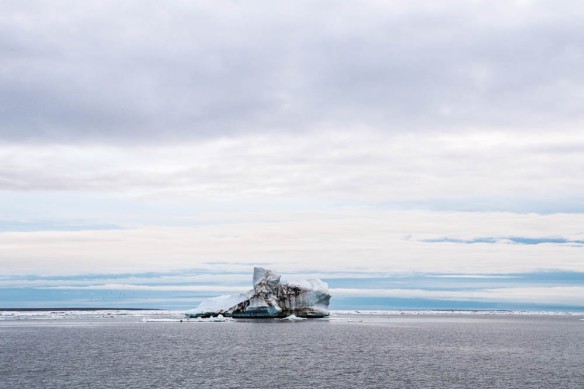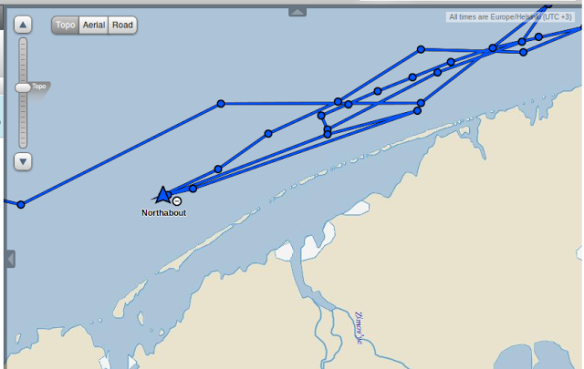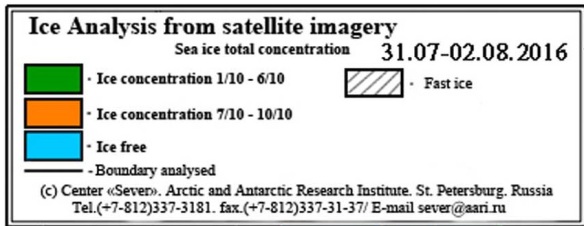The good ship Northabout is past the New Siberian Islands and plowing east, using their engines, across the East Siberian Sea. They actually experienced an entire day without seeing sea-ice, for the first time since they left the open waters of the Kara Sea, before they came across a few unmapped bergs. The main threat they have faced, and conquered, has been engine troubles.

If you look at the Bremen maps of recent years, you can see they might have formerly hoped to turn northeast and cut a corner, taking a sort of Great Circle route north of Wrangle Island.

No such luck this year:

If you hope to see an ice-free arctic, you likely favor the Bremen maps, for they tend to be MIM. (Much Ice Missing.) However if you are a sailor you don’t want to miss ice that is actually there, and are prone to look at the Russian maps, which are prepared for actual seafaring people. This shows the ice around Wrangle Island looks more formidable than the Bremin map shows. (Wrangle Island to right).

Rather than able to turn northeast and pass north of Wrangle Island, it looks like Northabout will have to turn southeast and hug the coast. This makes their route considerably longer. Then, once they pass under Wrangle Island, their problems are not over, as the larger Russian map still shows a second barrier of ice extending from Wrangle Island to the southeast, right to the coast.

The green color on the Russian map indicates the ice could vary between 60% and 10%, and you can bet the crew of the Northabout is hoping for 10%. They will likely be scanning the satellite maps for a more northern gap in the ice, for hugging the coast takes them even further south, likely adding an extra day to their sail, and they are running out of time.
(There is no turning back, as it looks like the ice has been blown south in the West Laptev Sea right to the shore. Not that they’d even consider it. Pilots crossing the Atlantic in the early days of flight used to speak of a “point-of-no-return”, (where it took more gas to reach land going back than continuing forward), and the Northabout has passed that point.)
The Bering Strait should be wide open, but towards Barrow yet another protrusion of ice juts down from the north, and the Barrow webcam shows that even the water that is blue on the Russian maps holds scattered bergs.

They are planning on spending a couple days in Barrow to re-provision, and exchange crew members. I am wondering if they might reconsider the wisdom of battling on. The Russian map shows ice touching the coast, where the Canadian Ice Service shows open water at the southwest opening to the Northwest Passage. (I would tend to trust the Canadians in their own waters.)

The satellite has very clear skies over the southern part of the Northwest passage, showing ice-free waters, but blasted clouds hide the areas of interest to the east and west. The satellite view does give us a dim view of where the Canadian Map shows some ice threatening to close the passage where it jogs north.

For selfish reasons I hope they continue on, so I can get first-hand reporting. However I think the good crew of the Northabout may be getting tired of discovering ice where maps, especially the Bremen map, says it isn’t.
(I’ll try to include some temperature maps in an update, later.)
USING MY LYING EYES
O-buoy 14 has drifted slowly against the normal flow of the Beaufort Gyre, southeast to 75.9°N, 136°W. Its camera gives us an opportunity to use our eyes, rather than trusting in maps. What does it show us?

As we have been seeing for several days, O-buoy 14, after a brief stint in open water, is midst a mass of pulverized ice, currently with some open water in the upper right distance, and a small patch of open water ruffled by the breeze in the mid-foreground. But what leaps out, to me at least, is the slushy water in the foreground. It is refreezing, and even rounding the sharp edges of some bergs into a formation called “pancake ice.”
This is what I love about these arctic cameras. You can’t get this information from graphs. What do graphs show us?
The temperatures have been below freezing.

It is still breezy, though winds have slacked off some.

One thing I have witnessed too often is how Alarmists and Skeptics can look at the exact same graphs and come to very different conclusions, and paint very different pictures. The camera frees us from that. The picture is painted by an Artist far greater than any of us. The Truth is there, for eyes that see.
With my weak vision I see the yearly battle between basal melting and surface freezing underway. The surface freezing always wins in the end, but right now we exist in a marvelous equipoise, even as the daylight dwindles and the big chill gains strength. For a time the refreeze makes inroads, and then a thaw fights back and basal melting can eat surprising holes.
If you are the captain of a ship your eyes must be constant assessing the situation. In the old days the whaling ships dared sail far north, seeking the un-hunted whaling grounds, but they had to time their escape south right, or their ship would be trapped. Now the captain of the Northabout sails the same seas, scans the same situation, and wears the same shoes. The responsibility is not small, when you are not sitting in an armchair far away, making excuses for the fact the Pole isn’t as ice-free as you thought it would be. You face a sea that doesn’t care about excuses.
*******
I promiced I’d look at the temperatures the Northabout may face, so I’ve gone to the Weatherbell Site and poured through some of the thousands of maps Ryan Maue makes available. I prefer the Canadian maps in the short term, for they know their business up north, [but I have to shake my head at the “JEM” model’s habit of foreseeing fabulous storms in the long term. I have learned not to panic, for the major hurricanes roaring up the east coast of the USA haven’t happened (so far.)]
The days are still longer than the nights, and one thing the midday maps show in any arctic area is how toasty warm the Tundra gets. Look how nice and warm it is in inland Alaska today.

However look at inland Alaska only 12 hours later. Much colder. This doesn’t happen in high summer, and what it shows is that the nights are swiftly growing longer, and starting to have a definite chilling effect.

The above maps also show that the storm I dubbed “Ralph” is sitting north of Greenland, keeping a lot of cold air wrapped up and trapped in its circulation. It also shows a sort of “feeder band” of juicy air poking north through westernmost Siberia, to fuel further mischief and perhaps keep “Ralph” going. Likely a secondary storm will brew in the Laptev, and the Northabout, being well to the east, will be blessed by southerly winds that push the ice away from shore.
However when I glace at the winds shown by the JEM modle for Tuesday, the south winds look fairly strong at Wrangle Island. Once winds get above 20 mph they can actually slow you down, because you have to reef your sails.

Also I should say the map looks messy. Chaos is rearing its head, and computer models like things nice and neat. So I’m not sure I trust the forecast.
Check out the temperature map for five days from now. Remember, days are still longer than nights, and at noon in Siberia it should be nice and toasty over the Tundra.

For goodness sake! That ridiculous model is showing an arctic outbreak of freezing temperatures blasting south nearly to China! And it is only August!
This could get me off into a long digression about a loopy ( or “meridional”) jet stream, but I am fairly certain the good ship Northabout is not overly concerned about the weather in China. They only look ahead to Barrow. And things do look a bit warmer there.
One fun thing to do with these maps is to open them on new tabs, and click between them. When I do this, and compare the 24-hour temperature map with the 120-hour temperature map, the warming at Barrow is plain, but when you head further east to the Northwest Passage, you see the big chill sneaking south. The outbreak may be far smaller than the one blasting towards China, but it is there.
“Polar Challenge” indeed. The Northabout has quite the battle ahead.
The thing of it is: Even to complete the Northeast passage is quite an achievement, in a small boat. I won’t mock or shame the Northabout if they haul out at Barrow, and say, “Wait until next year!”
After all, that is what certain “Climate Scientists” do. Year after year they say “this summer the Pole will be ice-free.” Year after year they are dead wrong, yet the government showers them with money. Surely the Northabout deserves the same, if they too say “wait until next year.”
But…..(and forgive me for pouting just a little here)….what about me? Year after year I am dead right. What do I get?
(Sigh)…….nothing but abuse.
MONDAY UPDATE
They continue to slog east-southeast. Making decent time, but the winds are starting to turn against them, and the going may be a bit rough tomorrow, I fear.

From their blog:
“N71 13 E161 12 Pressure 1007, Water 6, air 0, UTC 20:30, 22 Aug, East Siberian Sea
Wind against us, so choppy seas. We also got the latest sat photo this morning and having to go further south even more to avoid the ice.
BUT slowly going East. Ice tomorrow I think. The Irish in 2004 had a torrid time around here with the ice, so hoping we get better luck…”
Strong southeast breezes start blowing south of Wrangle Island tomorrow night and persist several days.

TUESDAY MORNING UPDATE
Yesterday the good ship had to assume a heading of due south and even southwest to avoid the southern edge of a tongue of ice. They got all the way down to latitude 70° north before turning east, and successfully negotiating the southern edge. Now they are plugging east at 9-10 kmh.
Finding ice so far south doesn’t further the assertion we are close to having an ice-free Pole this summer, but it does further my statement last spring that the ice had been pushed over to the Russian side. They hope to find smoother sailing on the North American side.
Coming so far south puts them further away from the tail end of the six months of “midnight sun” at the Pole, and they experienced actual night and saw their first stars in months. They also shared a truly marvelous photograph, with northern lights:

This picture, besides being beautiful, demonstrates how all the arguements about how the low “albedo” of September’s open waters means the water absorbs sunlight are hollow. The waters in the picture are losing heat, and warming the moonlight.
It looks to me as if south winds should push the ice ahead of them north, and clear their path to Barrow, though I’m sure they’ll take extra care at night to be on watch for stray bergs.
“Yesterday was very interesting, we plodded south to avoid the ice. I came up early to get ice on my watch. Oddly, with the sun in the right direction you get a thing called ‘Fata Morgana’ and the ice looks like towering ice cliffs. You can understand why the early explorers saw these cliffs and thought the route barred.
Then Sunset. Poor Constance had a full watch of dodging ice in the dark, thank goodness eating that bird seed has helped her night vision. Then our first star and a dazzling first display of the Aurora Borealis. What a day.
The new ice charts showed we were right to come south, and now just skirting the southern edge. Now hopefully a straight line to Point Barrow. Get those eastings up. Amazingly, the ice charts show how lucky we are, the Laptev sea is now closed behind us.”










 .
.
















